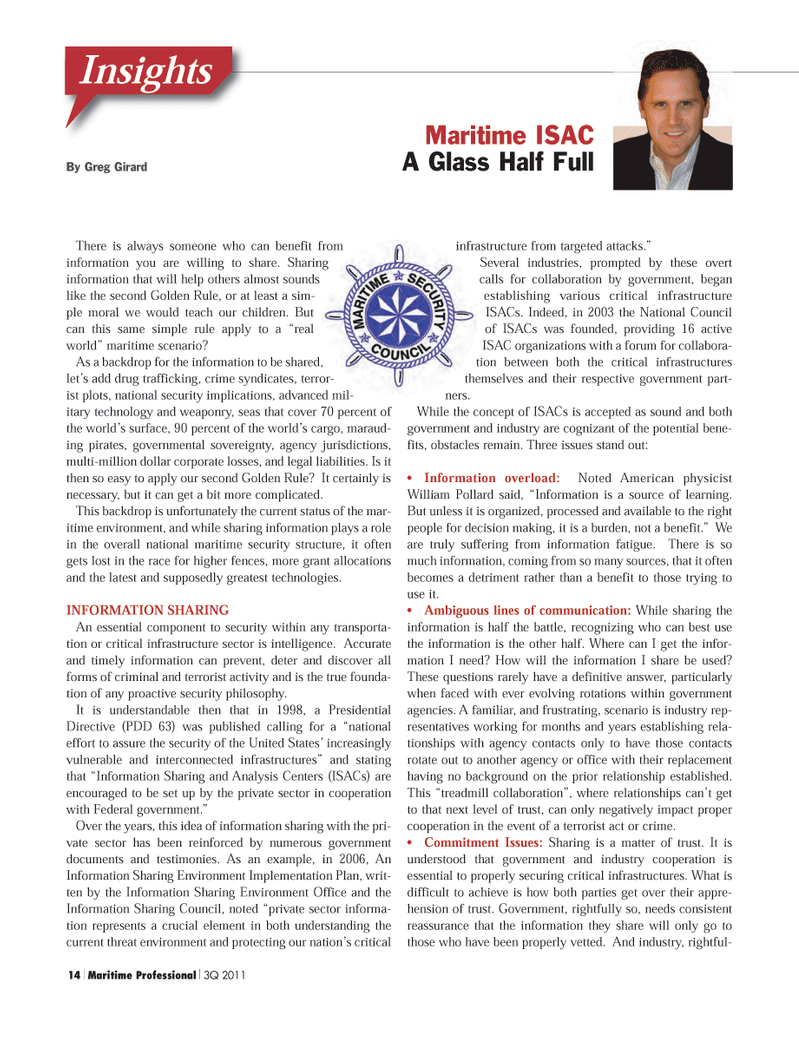
Page 14: of Maritime Logistics Professional Magazine (Q3 2011)
Maritime Security / Maritime Training & Education
Read this page in Pdf, Flash or Html5 edition of Q3 2011 Maritime Logistics Professional Magazine
14 Maritime Professional 3Q 2011There is always someone who can benefit from information you are willing to share. Sharinginformation that will help others almost soundslike the second Golden Rule, or at least a sim- ple moral we would teach our children. But can this same simple rule apply to a ?realworld? maritime scenario? As a backdrop for the information to be shared,let?s add drug trafficking, crime syndicates, terror- ist plots, national security implications, advanced mil- itary technology and weaponry, seas that cover 70 percent of the world?s surface, 90 percent of the world?s cargo, maraud- ing pirates, governmental sovereignty, agency jurisdictions, multi-million dollar corporate losses, and legal liabilities. Is it then so easy to apply our second Golden Rule? It certainly isnecessary, but it can get a bit more complicated. This backdrop is unfortunately the current status of the mar-itime environment, and while sharing information plays a role in the overall national maritime security structure, it often gets lost in the race for higher fences, more grant allocationsand the latest and supposedly greatest technologies.INFORMATION SHARING An essential component to security within any transporta- tion or critical infrastructure sector is intelligence. Accurateand timely information can prevent, deter and discover all forms of criminal and terrorist activity and is the true founda- tion of any proactive security philosophy. It is understandable then that in 1998, a PresidentialDirective (PDD 63) was published calling for a ?national effort to assure the security of the United States? increasingly vulnerable and interconnected infrastructures? and statingthat ?Information Sharing and Analysis Centers (ISACs) are encouraged to be set up by the private sector in cooperation with Federal government.? Over the years, this idea of information sharing with the pri- vate sector has been reinforced by numerous government documents and testimonies. As an example, in 2006, An Information Sharing Environment Implementation Plan, writ- ten by the Information Sharing Environment Office and the Information Sharing Council, noted ?private sector informa- tion represents a crucial element in both understanding thecurrent threat environment and protecting our nation?s critical infrastructure from targeted attacks.? Several industries, prompted by these overt calls for collaboration by government, began establishing various critical infrastructure ISACs. Indeed, in 2003 the National Council of ISACs was founded, providing 16 active ISAC organizations with a forum for collabora- tion between both the critical infrastructuresthemselves and their respective government part- ners.While the concept of ISACs is accepted as sound and both government and industry are cognizant of the potential bene- fits, obstacles remain. Three issues stand out: Information overload: Noted American physicist William Pollard said, ?Information is a source of learning.But unless it is organized, processed and available to the right people for decision making, it is a burden, not a benefit.? We are truly suffering from information fatigue. There is so much information, coming from so many sources, that it often becomes a detriment rather than a benefit to those trying to use it.Ambiguous lines of communication: While sharing theinformation is half the battle, recognizing who can best usethe information is the other half. Where can I get the infor-mation I need? How will the information I share be used? These questions rarely have a definitive answer, particularly when faced with ever evolving rotations within government agencies. A familiar, and frustrating, scenario is industry rep- resentatives working for months and years establishing rela- tionships with agency contacts only to have those contacts rotate out to another agency or office with their replacement having no background on the prior relationship established. This ?treadmill collaboration?, where relationships can?t get to that next level of trust, can only negatively impact proper cooperation in the event of a terrorist act or crime. Commitment Issues: Sharing is a matter of trust. It isunderstood that government and industry cooperation is essential to properly securing critical infrastructures. What is difficult to achieve is how both parties get over their appre- hension of trust. Government, rightfully so, needs consistent reassurance that the information they share will only go to those who have been properly vetted. And industry, rightful- InsightsMaritime ISACA Glass Half FullBy Greg Girard MP #3 (1-17):MP Layouts 8/17/2011 8:31 PM Page 14

 13
13

 15
15
